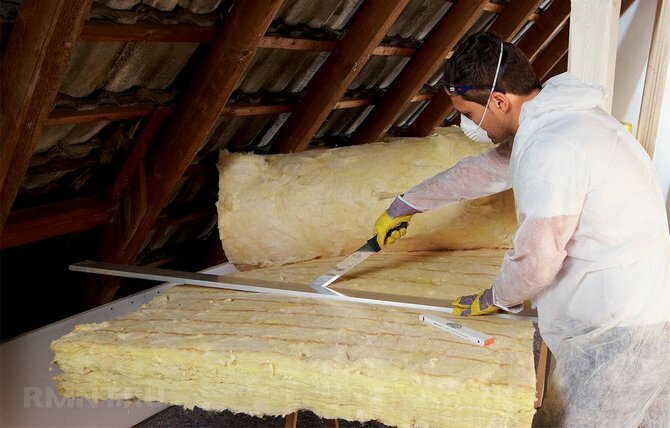Wallpapers on an elastic non-woven base have an original design, look stylish, and also allow you to hide minor wall defects. But the cost of material and work on pasting walls is not a cheap pleasure, do you agree?
Why not save money by hanging wallpaper on your own? And how to do this and where to start, we will tell in our article. Consider how to properly glue non-woven wallpaper, analyze the intricacies of surface preparation, show you how to cut the canvas and fit the pattern. So that the canvas does not swell and fall off, we will reveal to you the professional tricks of gluing.
The content of the article:
-
Gluing technology and material calculation
- The subtleties of gluing and joining canvases
- How many rolls will be needed?
- Adhesive selection and consumption calculation
-
Wallpapering steps
- Step #1 - Preparing the Tools
- Step #2 - Preparing the Walls
- Step #3 - diluting the glue
- Step #4 - cutting the canvases
- Step #5 - Adjusting the Pattern
- Step #6 - Marking the Walls and Applying Glue
- Step # 7 - installation of canvases
- Subtleties of wallpapering alone
- Expert advice for beginners
- Conclusions and useful videos on the topic
Gluing technology and material calculation
Non-woven fabric is wider than paper and weighs more. It can be painted (white or colored), embossed or with a decorative coating (vinyl, textile, paper).
The technique of gluing such wallpaper comes down to eight basic rules:
- Glue must be of the required density and viscosity.
- Wallpaper needs to be glued after puttying, priming the walls.
- Apply the adhesive directly to the walls, and not to the non-woven backing, unless the latter is specified by the fabric manufacturer.
- Follow the direction of the pattern, the order of which is indicated by special symbols on the packaging of the wallpaper.
- Adjust the pattern along the edges: either in a straight line, when the strips are glued in one direction or reversely - glue the strips in the opposite direction.
- Press the wallpaper from top to bottom, smoothing it with a wallpaper spatula or wallpaper brush, and roll the joints with a roller with a rubber base.
- The finishing material should be glued without seams, in a joint.
- Observe the same temperature regime in the room, avoid drafts.
The listed rules will help to carefully glue non-woven wallpaper, choose the right pattern, and prevent the appearance of air patches.
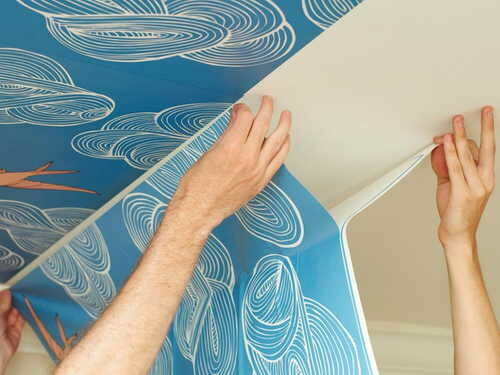
After preparing the walls, including leveling the surface, priming, the non-woven wallpaper is glued in one direction, the pattern is adjusted along the edges of the panels
The subtleties of gluing and joining canvases
To avoid misunderstandings in the process of gluing, before starting work, read the instructions for using wallpaper and glue. It is important to choose the right adhesive base - designed for gluing non-woven wallpaper. An unsuitable composition increases the risk of low-quality gluing.
Tips for gluing and the subtleties of joining canvases:
- Start gluing from the window openings in the direction of the line of sunlight. So the seams will be invisible.
-
Match the wallpaper patterns, following the manufacturer's recommendations and the diagrams on the package. So you can get the effect of a solid picture.
- For accurate gluing, first fix the wallpaper from the top to the center, then along the edges.
- Do not cut many sheets at one time. Customize the canvases individually at the place of their gluing, combining the pattern.
- Correctly determine the top and bottom of the wallpaper in the roll. Leave 5-10 centimeters for alignment on top, and align the bottom with the baseboard.
When gluing non-woven fabrics for painting, you must first wait until the surface is completely dry. And only after that you can start painting the wallpaper.
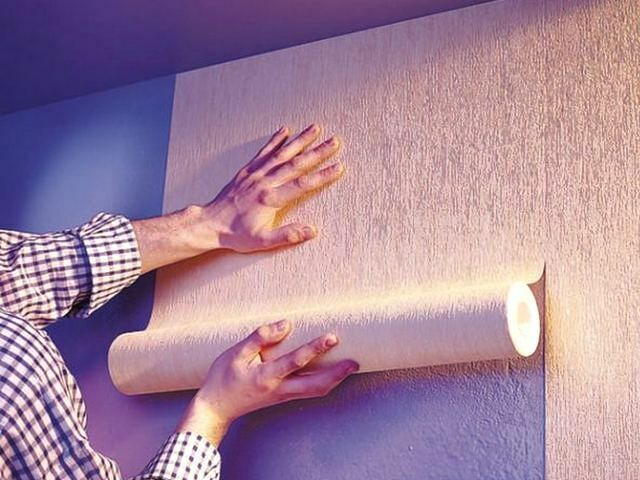
Gluing plain non-woven wallpaper will greatly simplify the task: it will eliminate the need to adjust the pattern, hide minor irregularities and defects on the surface of the walls
If you have never pasted non-woven wallpaper, we recommend that you stop at a plain version. This material is easier to work with. Texture without relief minimizeserrors, hide minor defects.
How many rolls will be needed?
To calculate the number of rolls, multiply the height by the length of each wall. After adding the data obtained, determining the total area. Subtract the area of door and window openings from the amount received. This step can be skipped if the window is one or two and small. Then the area of the walls is divided by the area of the wallpaper in one roll - this will be the required number of rolls.
The result obtained is subject to correction:
- Increase the number of rolls based on the actual number of sheets. It is necessary to divide the length of the wallpaper of one roll by the height of the wall in order to find out how many canvases come out, for example, 10 / 2.6 \u003d 3 canvases of 2.6 m each + 2.1 m on the remainder. Therefore, the final number of rolls will have to be increased, starting from the required number of canvases.
- Increase the consumption of material to fit the pattern. If the wallpaper is not plain, then the pattern will have to be customized. The height of the pattern is called rapport, it is indicated on the package. In the most unpleasant scenario, the entire height of the picture will have to be cut off in order to correctly combine the canvases.
As a rule, finishers add two more rolls on top to fit the pattern. To simplify the gluing of canvases and reduce consumption, choose a plain material without a pattern.
Adhesive selection and consumption calculation
A high-quality durable finish directly depends on the chosen adhesive base, which can ensure good adhesion of the canvases to the walls and does not give yellowness.
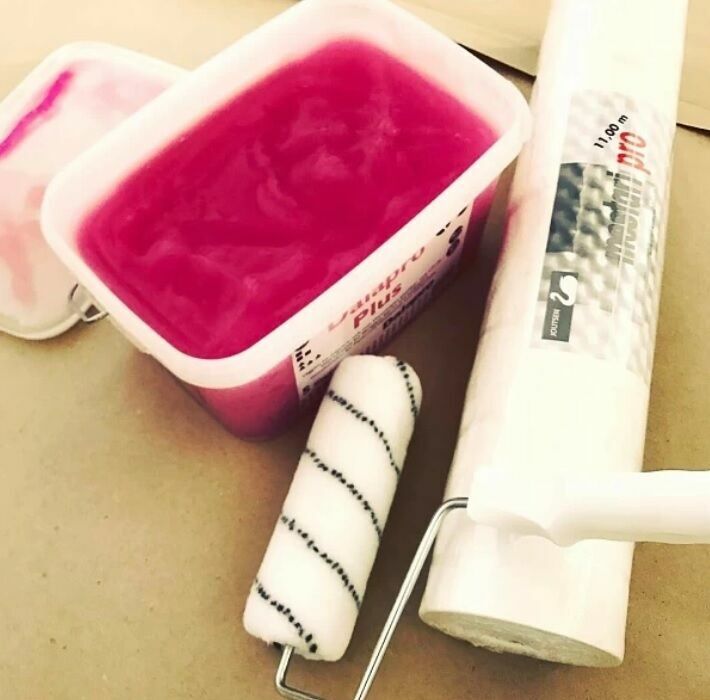
Glue for non-woven wallpaper is diluted to a thick consistency, but when applied it creates a thin layer and does not flow from the surface
Glue for light or heavy non-woven wallpaper is diluted to a thick consistency, applied in a thin layer, leaves no marks, smudges.
Available on the shelves are:
- Moment Interlining. It creates a good sliding wallpaper when docking, has additives against mold, fungi, retains its properties in a diluted form. For a material with a three-dimensional pattern, it is better not to use glue, it is also difficult to bring it to a homogeneous mass.
- German "Methylan Interlining ultra premium" and French "Quelyd Special interlining"- adhesive bases that work equally well with wallpaper with a three-dimensional pattern, without an ornament, hold light and heavy panels. These ranges from the middle price category are selected for smooth, corrugated, light or heavy wallpapers.
Among others, experts recommendKleo Non-woven», «FliziLex» as the optimal brand for gluing non-woven wallpaper.
The package will help you calculate the number of packs, where the number of rolls per box of glue is indicated. Therefore, it is necessary to divide the area of \u200b\u200bthe walls by the consumption (given on the pack) of glue in m2 and round the total up.
Wallpapering steps
To make the process of self-pasting walls with non-woven wallpaper more understandable, and the result will please you, we recommend step-by-step instructions, including the selection of the necessary tools, fitting the pattern, rules pasting.
Step #1 - Preparing the Tools
Before you start gluing, collect a set of universal equipment from: level - conventional or laser; a spatula made of plastic in standard sizes and a narrow one made of metal.
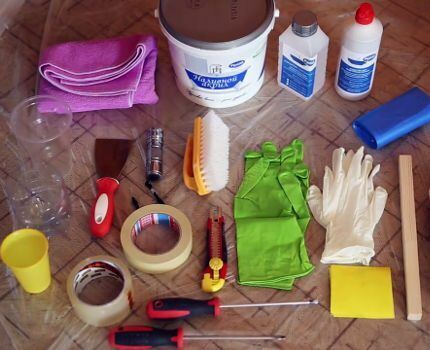
It is necessary to select tools for gluing in advance so that during work a spatula, roller, knife, etc. are at hand
You will also need a tape measure, a container for liquid and adhesive, as well as:
- a cuvette, which can be replaced by a mesh that removes excess glue from the roller;
- hand towel;
- pile roller, cone-shaped roller for corners and joints, rubber roller;
- knife with a sharp blade (removable);
- pencil or marker;
- foam rubber sponges;
- non-woven wallpaper;
- glue.
This list is supplemented with plastic wrap, a plumb line, scissors (for cutting excess wallpaper in the corners and near the joints), sandpaper, screwdrivers and gloves.
From building materials, it is advisable to put putty for leveling the walls and a primer to improve adhesion between the surface and the wallpaper.
Step #2 - Preparing the Walls
If the old finish is preserved on the walls, they first get rid of it. Old wallpaper is soaked, removed using a soft spatula.
The brick wall is puttied in two layers to cover up the cracks and smooth out defects on the surface. If the old wall decoration is a tile, they pry it off or beat it off with a mallet. After putty, they mask the holes, remove the boxes of switches, sockets, level the existing irregularities with a solution. Masters advise to wait until the putty is completely dry, and then sand the bumps with sandpaper.
The building level checks the result for the evenness of the applied putty layer, then the surface is primed.
If the walls were painted, then they are cleaned with sandpaper, and after removing the paint, the surface is puttied.
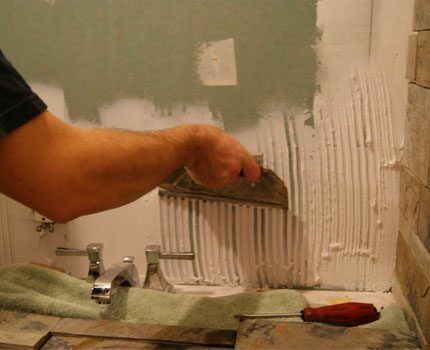
The surface of the walls is puttied and leveled, after which a primer is applied with a deep penetration of the composition into the walls
Check the strength of the puttied surface by drawing, for example, two intersecting lines with the tip of a knife. The remaining recesses, which do not have chips at the intersection, indicate the strength of the putty layer.
Let's not forget a few important features:
- If the wall is covered with oil paint, it must be cleaned. Then smooth with putty. Next primer - use a composition with deep penetration into the walls. So the wallpaper does not swell, does not fall off, but sticks firmly to the walls.
- For wallpaper for painting, a little paint is added to the primer composition. So the final color of the wall decoration becomes more uniform.
Do not forget to leave a margin of about 5-7 centimeters when preparing canvases, since in different parts of the room the height of the walls, as a rule, may differ. After preparing the walls, the wires (if any) are isolated, sockets with switches are unscrewed and removed.
Step #3 - diluting the glue
To properly dilute the glue, experienced craftsmen advise adding 200 ml of warm water (40-45 °) more than according to the rules within half an hour.
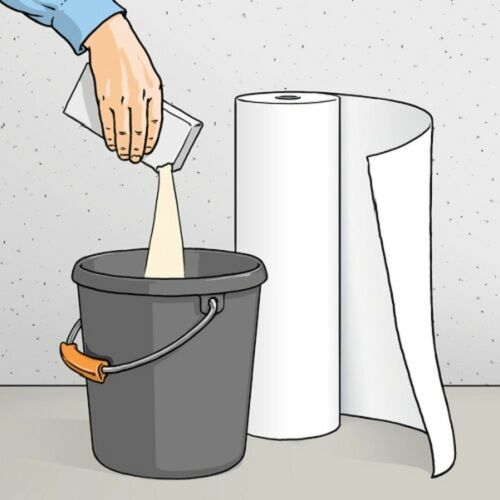
When choosing glue, it is better to stop at a special product for gluing non-woven material and follow the instructions for diluting the composition indicated on the package
Glue must be applied to the wall and only then applied wallpaper. It is necessary to start pressing the canvas on top of the wall, gradually going down.
Step #4 - cutting the canvases
Before cutting the canvases, the walls are measured in height from floor to ceiling in 4–5 different sections. From the obtained indicators, the maximum is chosen, for safety, throwing up to several centimeters from above.
Plain, unpatterned non-woven wallpaper does not require adjustment. Such webs are cut by drawing horizontal lines with a pencil or marker, in accordance with the previously obtained values. Along these lines, the wallpaper is cut with scissors or a knife.
Step #5 - Adjusting the Pattern
If wallpaper is to be cut, where there are patterns and a pattern, then they are unwound on the floor, the pattern is adjusted, for which the excess height of the pattern (rapport) is cut off. The size of the rapport is interconnected with the height of patterns and ornaments - the larger they are, the greater the step and the number of waste.
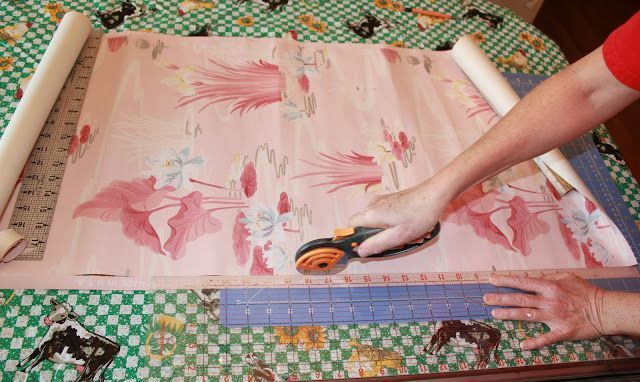
We combine the pattern on non-woven wallpaper so that two canvases are in contact with the same elements horizontally or with different horizontal elements
There are three steps to get started - customization according to the drawing, element marking, folding cut strips in the required sequence:
- First lay out two rolls of wallpaper on a clean floor. Given the height of the ceiling, a segment + 5-10 centimeters is measured from the first roll. The resulting strip is combined with the second one until the pattern of the first strip continues on a fragment of the second strip.
- Next, put marks at the point of contact between the fragments. On this frame, the canvas is cut with scissors. Usually the edge turns out to be uneven, and in order to align it, the 10 cm allowance left in advance will come in handy.
- On a strip of wallpaper with markings, the upper part is marked, then the canvas is removed for a while. To save space, the strips are placed vertically on the walls on which they will be glued in the future.
With the standard gluing technique, each cut strip is laid flat on top of the other so that the front side with the pattern looks at the floor. Similarly, in the case of non-woven wallpaper, only the upper strip is not smeared with glue.
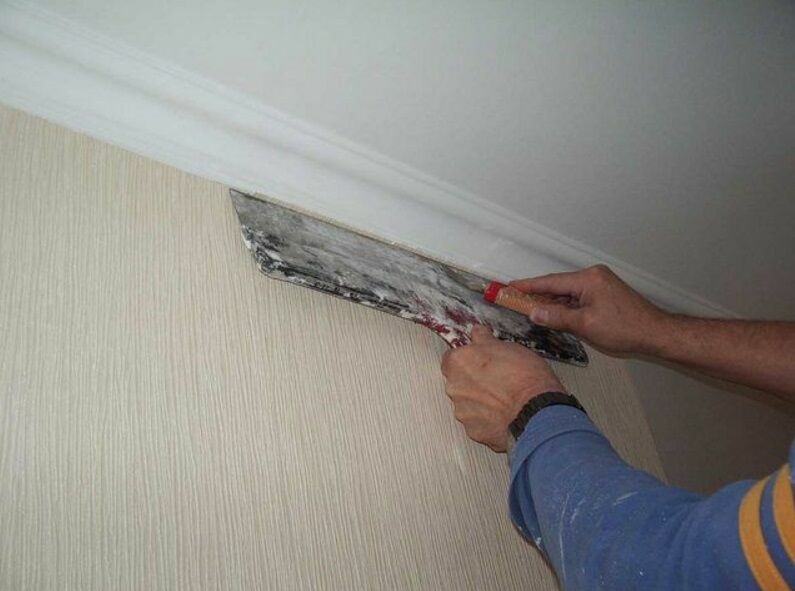
After applying the adhesive composition, apply the first strip, taking it by the ends from above so that it is 2 cm higher than the baguette (ceiling plinth)
Step #6 - Marking the Walls and Applying Glue
It is important to observe an even vertical strip when gluing the first piece and maintain the width of the adhesive strip, which is 5–10 cm larger than the width of the wallpaper.
In the future, focusing on the initial markup, the remaining canvases are glued. The markup starts from the corners of the walls, using a level for this. Vertical lines are applied exactly to the entire wall, maintaining a distance of 1 meter. Meter rolls are standard in a width of 106 cm, 6 of which are in stock.
Glue is best applied only to the wall. Sometimes the manufacturer advises to cover the wallpaper with glue as well. For a thick application of the layer, use a roller, carefully smearing the entire surface with it, paying particular attention to the corners. In hard-to-reach areas, a small brush is used.
Step # 7 - installation of canvases
Glue, cut the wallpaper in the following order: glue the first strip. To do this, apply the adhesive composition slightly wider than the width of the wallpaper, attach the first strip, taking it by the ends from above so that it is 2 cm higher than the baguette. Align according to the applied vertical mark. If it was not possible to do this right away, you need to lift the glued wallpaper from below, move them in the right direction.
The canvas, which lay in the correct vertical position, is pressed more tightly, smoothed with a roller, spatula, soft cloth. This procedure is performed from the center up, then smoothly down the sides of the canvas, controlling the formation of bubbles.
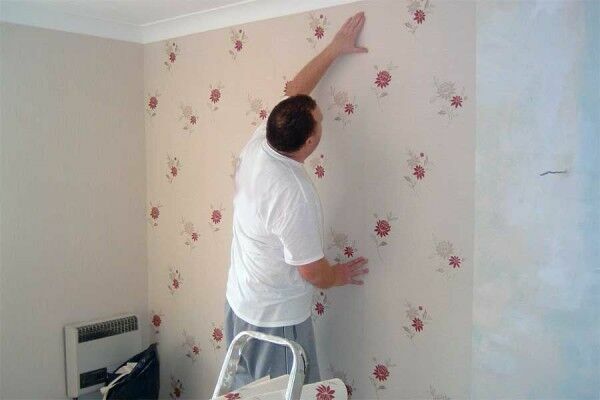
After preparation (puttying, priming, leveling the surface) of the walls, non-woven wallpaper is glued in one direction, the pattern is adjusted along the edges of the panels
Wallpaper trimming is done immediately upon completion of their gluing. Cut off the upper area, mark the cut line in parallel, drawing the blunt end of the spatula along the wallpaper strip under the baguette. In this case, the canvas, as it were, is pushed under the baguette, displacing excess glue and air.
After that, along the intended line, the excess is cut off with the sharp end of a spatula or a knife so that the canvas adjoins the baguette without external defects. The strip is cut along the edges in the areas of their joining with the surface. At this time, the spatula is evenly placed on the wall, excess material is cut off along its line.
To avoid nicks when cutting, the knife is not torn off the material, moved forward to the end of the spatula. Excess adhesive base is immediately wiped with a damp cloth.
Glue the remaining strips like this: smear the next section with glue, apply the canvas to the wall, holding it along the upper edge. To match the drawings, the wallpaper is shifted until the composition matches. The canvas is laid end-to-end with the first glued strip.
There should be no areas where wallpaper is overlapped.. They are very noticeable, especially on wallpaper for painting and spoil the appearance of the finish. In order for the pieces to fit snugly at the joints, they pass through this place with a spatula or roller up to several times.
We connect the corners correctly
In order for the wallpaper to lie evenly in the corners, it is better not to glue whole meter-long non-woven pieces.
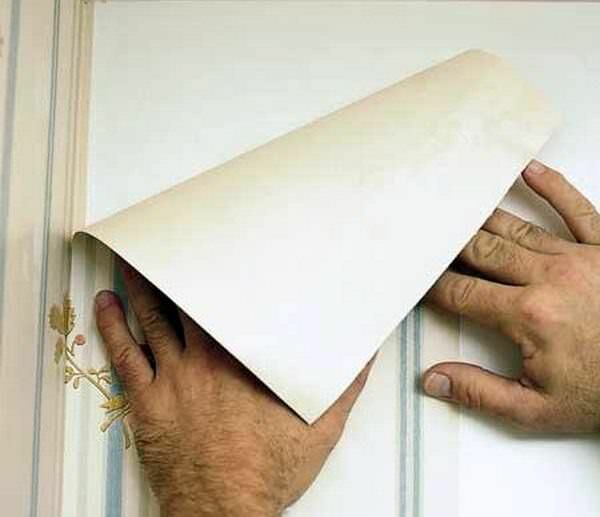
It is necessary to apply glue to the canvas, glue the wallpaper in the corners. The next piece of wallpaper is applied to the resulting ledge with an overlap
In internal, external corners, specialists paste wallpaper after measuring the distance of the segment from the last glued strip to the corner. 1.5-2 centimeters are added to the obtained value and the necessary piece is cut off. Glue is applied to the resulting canvas and the wallpaper is glued in the corners.
The next piece of wallpaper is applied to the resulting ledge with an overlap. Non-woven wallpaper must be glued closely. If the necessary joint is not obtained, the canvas is straightened.
It is necessary to apply glue in large quantities - this creates a good glide, thanks to which it is not difficult to move the strips towards each other and straighten them.
Nuances of gluing around doors and switches
In the case of a plain canvas, the wallpaper around the doors, sockets and switches is glued on the sides, leaving the necessary space. Then they measure, cut off the strip and dock it with the next one. From the resulting overlap, cut off the excess, fill in the gaps above the door, around sockets and switches.
If the wallpaper is with patterns, then the allowance is not made. Pasting is carried out with the adjustment of the pattern.
How to paste over the radiator area?
At the place where the radiators are, the pasting process is carried out either after dismantling the batteries, or by passing a strip under the radiators by about 15 centimeters.
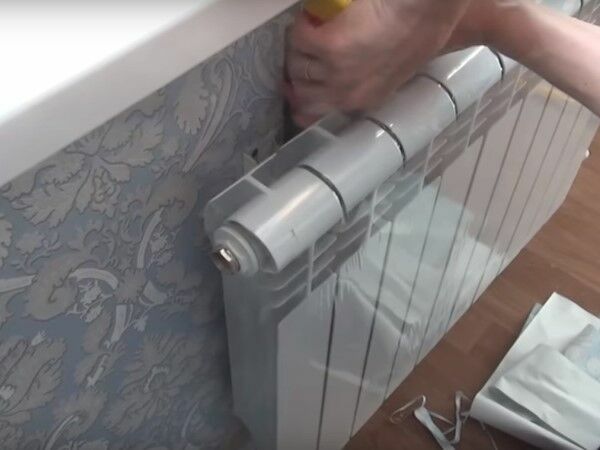
If pasting takes place during the heating season, the batteries are not dismantled, it is worth applying glue under them very carefully
The glue is applied carefully, otherwise, its excess will stain both the radiator itself and the surface of the non-woven fabric.
Subtleties of wallpapering alone
The steps for wallpapering are the same whether you're working alone or with two or three people. The difference is that from the necessary tools you need to stock up on a stepladder.
And take into account that it is possible to glue meter-long canvases to one person if they are on a non-woven base, which fits well at the seams, in the corners. And also easy to level without assistance. The span of the hands allows you to glue even meter-long non-woven wallpaper alone.
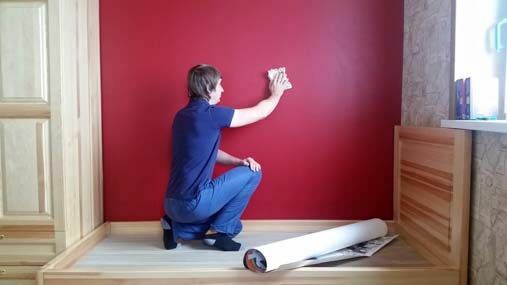
It is possible to glue the wallpaper without outside help: if an error occurs, the canvas is removed, and then it is re-glued evenly back to back
Do you want to change something in the interior, but are not ready to completely re-glue the rooms? We recommend taking a look at photo wallpaper - such a solution will refresh the room and take a minimum of time to repair.
Expert advice for beginners
In order to glue the wallpaper correctly and beautifully, one cannot do without certain knowledge, which can be gleaned from advice from professional decorators:
- Opt for a stepladder over a scaffolding - it's a more stable option.
- When pasting with a non-woven fabric, there is no need to smear the strips with glue in advance. It is applied to the walls.
- Get a neat edge will allow 1-2 centimeter allowance for slopes. Wait for the wallpaper to dry, then cut off the excess.
- Do not join the panels at the corners, make transitions from wall to wall with a large allowance, the size of which is equal to the length of the wall deflection in a vertical position.
- Remove excess fabric with a sharp knife blade.
Also, do not neglect the use of the building level - it is easier to glue the canvas with it.
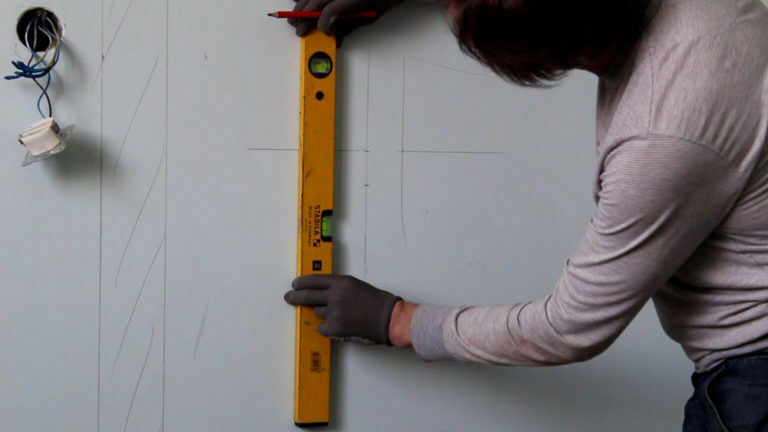
Be sure to use the building level. It helps to glue the wallpaper evenly, avoid irregularities, match corners, and do the job beautifully.
In the process of gluing, it is important to keep your hands clean, wipe them in a timely manner with a napkin, removing glue and dirt.
To avoid injury, experts advise laying plastic wrap on the floor after each sheet. But tiles and parquet are covered with cardboard or paper.
Conclusions and useful videos on the topic
Glue correctly non-woven wallpaper in the corners:
Sticking non-woven wallpaper with your own hands:
You can also glue meter-long wallpapers on your own. It is important to choose a non-woven base, calculate the number of canvases, stock up on the necessary equipment. And remember the advice of professional finishers, one of which is: the eyes are afraid, but the hands are doing.
After all, sticking non-woven wallpaper is not as difficult as it might seem..
If you have any questions, ask them in the comments below the article. Here you can also share your own experience of successfully pasting walls with non-woven wallpaper and talk about the difficulties you encountered in the process, or add original photos of the finished work.

